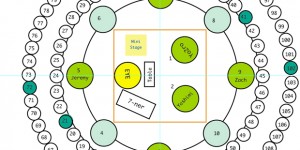CRAM SESSION: An intro to Japan's freak-rock legends Boredoms
by Jevon Voon
February 29, 2016
With smaller line-ups including 77 drummers and a seven-necked guitar, there's no other band like Boredoms.
Boredoms were formed by Yamantaka Eye (EY∃) in Osaka, Japan, arriving from the ashes of his confrontational Japanoise duo Hanatarash (who notoriously drove a bulldozer into a venue in 1986).
Their discography seems to exist far outside the spectrum of even the most experimental of punk, rock, and psychedelia. They simultaneously conflate the antiquated tropes of those genres with forward-thinking dance music, technologically advanced sound design, and communal krautrock catharsis. Contrary to the band’s name (which comes from the Buzzcocks song “Boredom”), their music is anything but; it’s the sonic embodiment of worshipping the sun and stretching out to harrowing extremes of cacophonous sound, like spiky but malleable neon wire.
In their three-decade long career, Boredoms have evolved from a solo tape recording project, to a (somewhat) traditional punk band, to a non-traditional psychedelic krautrock trance ensemble, to a massive, other-worldly, festival touring, rhythmic orchestra punctuated by an excessive amount of percussionists and a seven-necked guitar called the Sevena.
They are probably about as close to Bowie-like shapeshifters as modern experimental rock has ever conjured up, with a dizzyingly massive discography (including side-projects) and a particular focus on the visual art aspect, which is influenced by Japanese mythology and sandwiched somewhere between Dada and Darger (EY∃ created the artwork for Beck’s Midnite Vultures).
Along the way they’ve had a Flaming Lips album named after one of their members (percussionist and second longest serving member Yoshimi P-we, who is also featured on the album), toured with Nirvana and Sonic Youth, collaborated with John Zorn and Ween, were a major-label act for a decade, had percussionists such as Zach Hill (Death Grips, Hella), Kid Millions (Oneida), Jeremy Hyman (Ponytail, Avey Tare’s Slasher Flicks), Hisham Bharoocha (Soft Circle, Black Dice, Lightning Bolt) and Andrew W.K. take stints in the group. Boredoms also have the special three-peat honour of being selected by Simpsons creator Matt Groening, Neutral Milk Hotel’s Jeff Mangum, and now comedian Stewart Lee to play the All Tomorrow’s Parties festival.
Boredoms haven’t released any new music in more than five years but show no signs of slowing down, having spent the past few years continuing their Boadrum series overseas and playing new sets in Japan and England. Yoshimi P-we’s other band OOIOO have released a couple great albums (the last being 2014’s Gamel on Thrill Jockey) while EY∃ has kept busy performing alongside avant-turntablist Otomo Yoshihide in 2014 as part of the Red Bull Music Academy and spending 2015 preparing and conducting a laptop orchestra as part of a new project called EYE: CIRCOM, which follows the traditional Japanese three-part structure of Jo Ha Kyu.
Where Boredoms will go next is anyone’s guess, but in the meantime, take a look back at some of their releases:
Pop Tatari (1992) / Wow 2 (1993)
Pop Tatari is Boredoms’ third full length and second for a major label, Warner Music Japan and Reprise. It’s fairly strange that either label released music like this in the first place, considering that the latter was started by Frank Sinatra and has Green Day on its roster, but hey, it happened and we have what is considered by some to be one of the strangest major-label releases ever. The music itself is a delicious amalgamation of angular punk, primitive electronics and scat singing freakouts, taking the band’s frenetic live show at the time and injecting it with abrasive synth effects that add a sense of acceleration and a surprising melodic depth.
A particularly poignant moment come during “Bore Now Bore” when the guitar cuts out and a travelling ambient synth arp that wouldn’t sound too out of place in a Boards of Canada track comes out of nowhere to be quickly augmented with a steady tom, leading to a perfect stretch of controlled guitar-synth-vocal chaos.
Wow 2 is one of only two Boredoms live albums and it’s an impressive document of the band’s early shows. Recorded live in studio by John Zorn and Martin Bisi, the band rips through their angular scat punk with a confidence and energy very few can match. The production is sparkling and easy on the ears, revealing the rhythmic complexity underneath their freakouts. The saxophone on tracks like “Rat Soup” sounds fucking awesome as well.
Chocolate Synthesizer (1994) / Soul Discharge 99 (1994)
1994’s Chocolate Synthesizer is a massive trip and perhaps the most realized example of early Boredoms. It starts off on a minimal note, with the yelled call-and-response vocals of “Acid Police”, only to retract into quiet synth contemplation for the next two tracks. This unexpected nature is the pillar of the album, which dials up the melodic content while not dialling down the noise.
Released the same year, Soul Discharge 99 is a re-packaged version of their second album and major label debut of the same name (minus the 99). The re-issue has a slightly different (better) tracklist that flows much more like a peaceful stream in comparison to its cousin. Soul Discharge 99 and the Onanie Bomb Meets the Sex Pistols comp (which collects their debut album and EP and was also released in 1994) are each worth a listen to hear how the band progressed and are great albums in their own right, albeit slightly less essential than Pop Tatari or Chocolate Synthesizer.
Super Roots 3 (1994) / Super Roots 5 (1995)
The Super Roots series of EPs that Boredoms consistently put out from 1993 to 2009 is interesting in the way that you could guess where the band would go on their full-length records by listening to these EPs. Reserved for experiments and rarities, the series seemingly acted as a way for the band to try out ideas they wanted to explore in their major-label records, but without the constraints or pressure of releasing a cohesive full-length album statement.
Super Roots 3 and 5 mark the first overt changes in the group’s sound and is where they started putting the pieces together for the immersive trance rock they’d perfect by the turn of the millennium. Super Roots 3 contains a single, fairly conventional but energetic half hour punk track that steadily builds its shifting two-chord structure over its running time while Super Roots 5 takes that idea and stretches it to just over an hour while piling even more weird sounds over top, demolishing its conventions even further and landing it somewhere in a Futurist graveyard.
Super Roots 6 (1996) / Various Artists – Shock City Shockers (1998)
Super Roots 6 is the ambient anomaly in the Boredoms catalogue. For a group set on juxtapositions, grand statements and massive walls of yelping sound, the record sounds like nothing else they’ve ever done and manages to maintain a simple, peaceful focus throughout, giving off the feeling of a small stream running down a mountain wall.
After starting things off on a noisey note with what kind of sounds like a broken propeller engine, a minute of pure silence produces a segue to the first real track, “6”, which stands as one of the most overtly calm and downright beautiful pieces of music Boredoms has ever released. Drums and electric guitar pop up every so often to provide much needed breaks from the earthbound, ambient soundscapes, but it really is the koi pond that is on display here with stunners like “3”, “8”, and “13”.
Released two years later, Shock City Shockers isn’t technically a Boredoms album, it’s a “compilation” of tracks from artists on EY∃’s Shock City record label (although half the artists are actually just EY∃ under different pseudonyms). Despite this, Shock City Shockers is important and acts as sort of a companion record to Super Roots 6.
These two are where the group re-evaluated their structures, ditching the hyperactive angularity for something a bit more akin to minimalism and dance music, especially the sounds of jungle and drum ‘n’ bass. This is particularly evident on EY∃ tracks like “7EY∃7” and “FREEEY∃”. Yoshimi’s OOIOO also makes a lovely appearance with “Asozan”, which would later appear on their excellent 1999 album Feather Float (which by the way, has fucking incredible artwork).
Super Ae (1998) / Super Roots 7 (1998) / Super Roots 8 (1999)
For me, Super Ae is the best of all the Boredoms records. This album kind of feels like staring directly into the sun through 3D glasses; the holy bible of the Boredoms brand of sun-worshipping frequencies. A long-form mixture of hardcore punk, krautrock, and psychedelia, with plenty of catchy affected call-and-response vocals from EY∃ and Yoshimi P-we and ear worm studio effects that don’t hide their debt to the dance floor (the filter work in Super Ae is particularly impressive). I’ve always thought this would be a good alternate soundtrack to F-Zero, Wipeout, or San Francisco Rush 2049.
Super Roots 7 and 8 are technically both cover records but each contain one of the best songs the band has released to date. Super Roots 7’s 2nd track, “7-> (Boriginal)” is essentially a cover of The Mekons’ “Where Were You?” as jammed out by Neu!, which is great.
Super Roots 8’s first track is a cover of a theme song from a Japanese children’s show called Jungle Taitei. After the extended intro, It’s probably as close to a proper pop song that Boredoms have ever released and is a bite-sized chunk of a pummelling drum orchestra cranked in the mix, with droney, psychedelic soundscapes passing underneath and incredibly catchy vocalizations overtop. There’s a couple of legitimate drops that surpass the excitement of festival EDM and as a whole is a good example of middle Boredoms in a short period of time. One to show the parents.
Vision Creation Newsun (1999)
Vision Creation Newsun is by a far margin the most accessible record in the Boredoms catalogue and probably the best place to start if you’re trying to get into them. This is evident not so much in the music, which is the perfect relaxing, stoned Sunday afternoon version of their sound, but more so in the YouTube video comments on the album; somehow it has managed to spawn up a small meme that is essentially “Listened to this album while ________ , one of the craziest experiences of my life”. Weird.
Maybe these people were taken back by the particularly impressive guitar playing of Seiichi Yamamoto on the impressive three song stretch of “Ҩ”, “~”, and “◎”. Oh yeah, with the exception of the last track, all of them are officially represented with a symbol.
DJ Pika Pika Pika – Planetary Natural Love Gas Webbin’ 199999 (1999)
DJ Pika Pika Pika is an alias of EY∃, which had previously shown up on Shock City Shockers. One of the more rave-friendly monikers he has used, the only album released under the name is quite the party. It’s essentially a massive DJ mix of sped up hyper jungle and hardcore edits, but filtered through the kaleidoscopic sample-heavy lens of Boredoms psychedelia.
A particular WTF moment comes courtesy of the inclusion of Australasia & Suns of Arqa’s “Sul-E-Stomp (Ceilioh Mix)”, which is pretty much a cosmic bagpipe trance jaunt overtop techno beats. This and the Rebore series of Boredoms remix EPs (especially the fourth instalment, Rebore Vol. 0) are a striking document of EY∃’s interest in rave culture and dance music.
77 Boadrum live CD (2008) and DVD (2010)
It might seem odd that we’re jumping a decade into the future but during the early aughts it seemed like Boredoms had taken a hiatus. There was 2004’s Seadrum/House of Sun to fulfill their last major label album in Japan but it was compiled from older recordings and seemed to be a rehashing of territory they had previously traversed.
They returned in 2007 to host this insane event which took place on July 7th at Empire-Fulton Ferry State Park in Brooklyn. Gathering together an ensemble of 77 drummers, they performed a massive outdoor concert just under the Brooklyn bridge. This was documented through the CD that was released through Commmons in Japan in 2008 and the DVD which was filmed and released by Vice Records in 2010. The DVD is highly recommended as it’s quite a magnificent spectacle to vicariously witness with your own eyes.
The band would expand this concept in 2008 to include 88 drummers and would continue the series with concerts happening as recent as 2015 (mainly in England).
Super Roots 10 (2009)
Super Roots 10 is the last of the Super Roots EP series that was released on Commmons in Japan and Thrill Jockey in the US. It’s a fairly minor entry but contains my absolute favourite Boredoms song, “ANT10”, which is one of the more strictly electronic tracks the band has released. It contains some glistening melodic arpeggiated synth ripples that interact with their trademark wall of drums beautifully, elevating you off your seat while the persistent 4/4 kick drum rounds out the concoction with a much needed dose of sub-bass, not something you usually hear on a Boredoms record.
On top of that, an absolutely jaw-dropping remix of ANT10 is included courtesy of Lindstrom, who invites Boredoms’ blistering psychedelia to his own funk-infused disco rave to a blissful effect. The YouTube video of the remix states it to be “THE BEST REMIX EVER” and I can’t really disagree with that claim.
Live at All Tomorrow’s Parties “I’ll Be Your Mirror” Tokyo (2011)
This is a full live concert of currently unreleased material captured at All Tomorrow’s Parties “I’ll Be Your Mirror” festival in Tokyo on February 27th, 2011. Fully displaying their naive blend of primitive virtuosity and forward-thinking technology conducted with a streamlined and natural, almost hippie mentality, the set featured EY∃ surrounded by six drummers in a circle. He used motion sensors to conduct and trigger ambient soundscapes created by Shinji Masuko (founder of DMBQ, Boredoms’ current guitarist and designer of the Sevena) that would correspond to each drummer.
It’s an absolute delight to watch the ensemble demonstrating this process by starting the concert very slowly as each drummer builds up the intensity based on EY∃’s body movements. There’s a moment in part four of the video where EY∃ creates a whirlwind of sound by spinning around in a circle. It’s a stunning moment of ecstasy and exhilarating to watch, much like the progression of the band throughout the years.





